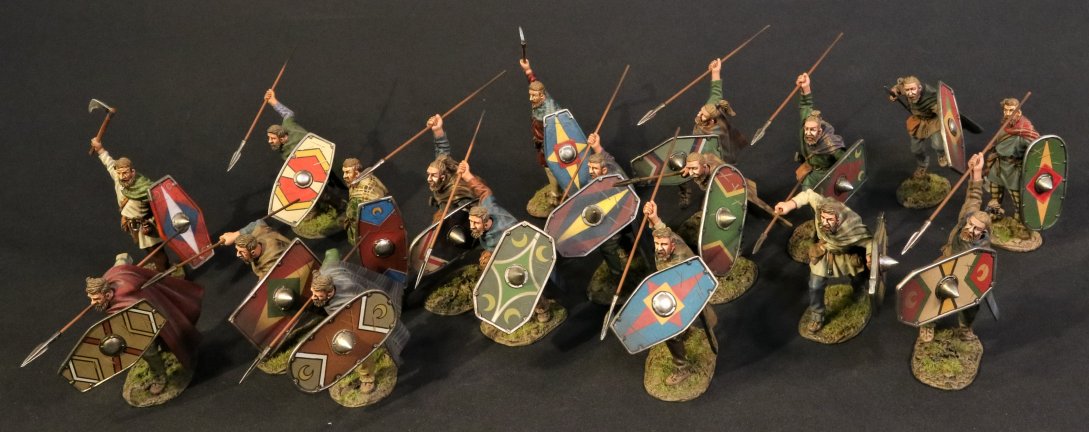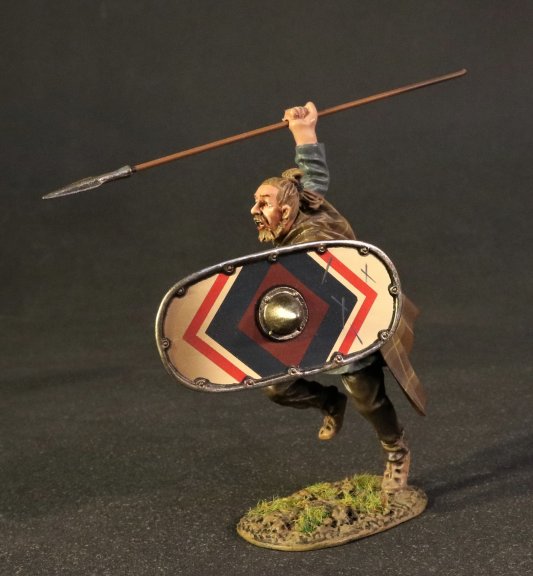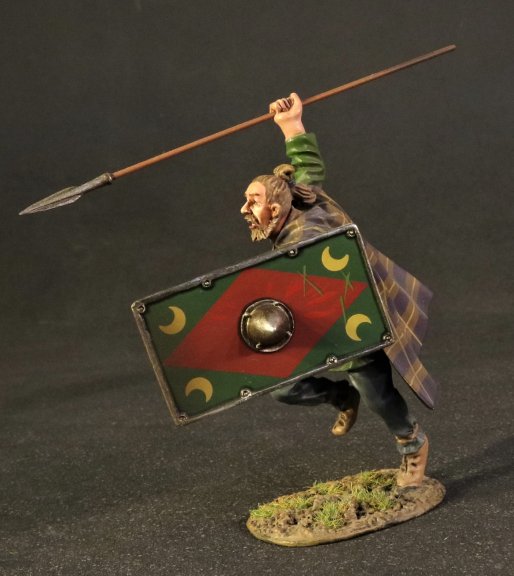- Joined
- Feb 2, 2011
- Messages
- 2,093
NEW RELEASES FOR APRIL 2021
THE ANCIENTS COLLECTION
ARMIES AND ENEMIES OF ANCIENT ROME
REPUBLICAN ROMANS
THE ROMAN ARMY OF THE LATE REPUBLIC
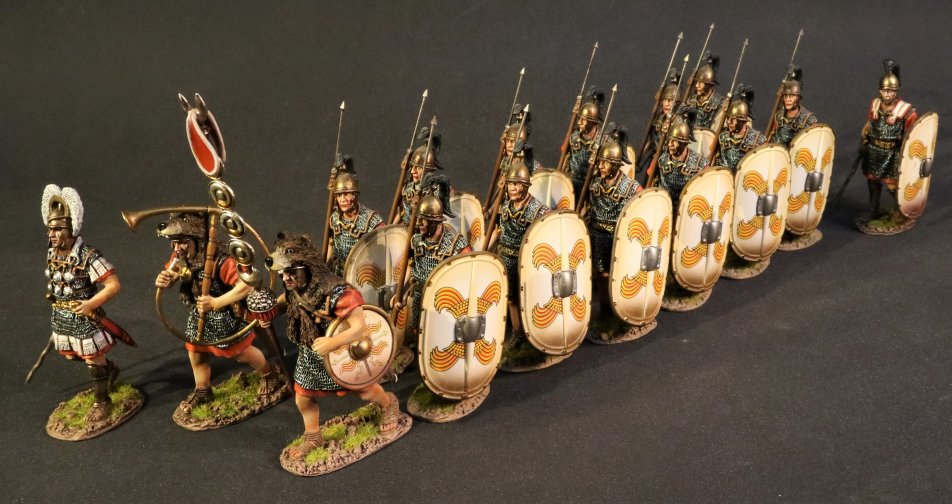
By the first decades of the 1st century, the COHORT had replaced the maniple as the standard tactical unit of the legions.
The three lines of the manipular legion were combined to form the cohort, which generally numbered about 480 to 500 men. Maniples and centuries continued to be used as military and administrative subdivisions for the cohort.
There were six centuries in a cohort, which were now all 80-men strong.
Each Centuria was commanded by a Centurion, and also included an Optio, a Signifer and a Cornicen.
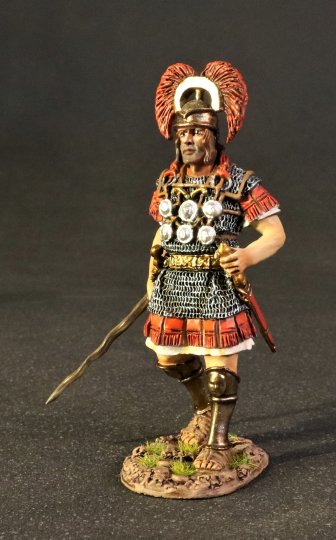
RR-01AR
ARMIES AND ENEMIES OF ANCIENT ROME,
THE ROMAN ARMY OF THE LATE REPUBLIC,
CENTURION.
(1 pc)
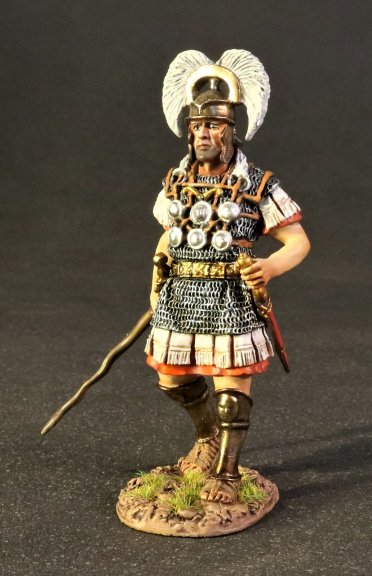
RR-01AW
ARMIES AND ENEMIES OF ANCIENT ROME,
THE ROMAN ARMY OF THE LATE REPUBLIC,
CENTURION.
(1 pc)
The Centurions also appointed the bravest men as standard bearers, or Signifers.
A signifer was a standard bearer of the Roman legions. He carried a signum (standard) for a cohort or century. Each century had a signifer so there were 59 in a legion. Within each cohort, the first century's signifer would be the senior one.
The signum that he carried was the military emblem of that unit. It had a number of phalarae (disks or medallions) along with a number of other elements mounted on a pole. The pole could be topped with a leaf-shaped spear head or later a manus (open human hand) image denoting the oath of loyalty taken by the soldiers. It sometimes included a representation of a wreath, probably denoting an honour or award.
The task of carrying the signum in battle was dangerous, as the soldier had to stand in the first rank and could carry only a small buckler. It was that banner that the men from each individual century would rally around. A soldier could also gain the position of discentes signiferorum, or standard bearer in training. If the signifer was lost in battle, the whole unit was dishonored.
In addition to carrying the signum, the signifer also assumed responsibility for the financial administration of the unit and functioned as the legionaries' banker. He was paid twice the basic wage.
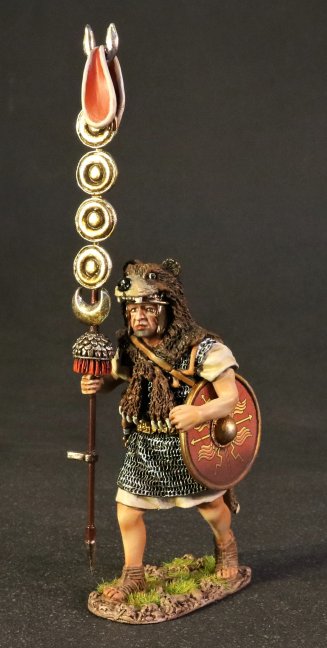
RR-02AR
ARMIES AND ENEMIES OF ANCIENT ROME,
THE ROMAN ARMY OF THE LATE REPUBLIC,
SIGNIFER.
(1 pc)
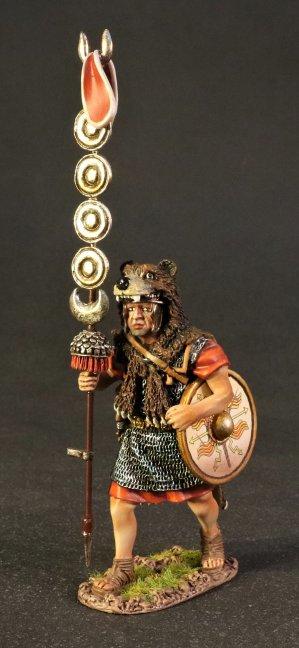
RR-02AW
ARMIES AND ENEMIES OF ANCIENT ROME,
THE ROMAN ARMY OF THE LATE REPUBLIC,
SIGNIFER.
(1 pc)
An Optio was an officer appointed by the centurion, and was stationed at the rear of the centuria to keep the troops in order. Their duties would include enforcing the orders of the centurion, taking over the centurion's command in battle should the need arise, supervising his subordinates, and a variety of administration duties. Optio pay was double the standard legionary pay and they were the most likely men to replace the centurion if the position became vacant.
A Centurion at this time can be distinguished from other Legionaries by several methods. He usually wore greaves, and the crest of his helmet was usually turned so it ran transversely across the helmet. His sword was worn on the left and his dagger on the right which is the opposite of a Legionaire.
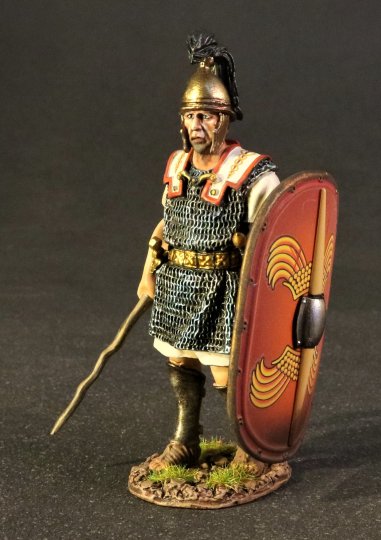
RR-03AR
ARMIES AND ENEMIES OF ANCIENT ROME,
THE ROMAN ARMY OF THE LATE REPUBLIC,
OPTIO.
(1 pc)
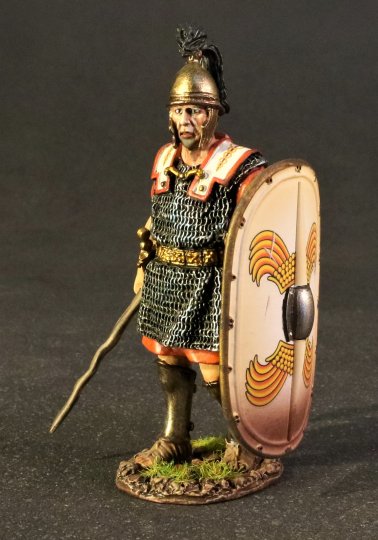
RR-03AW
ARMIES AND ENEMIES OF ANCIENT ROME,
THE ROMAN ARMY OF THE LATE REPUBLIC,
OPTIO.
(1 pc)
Each Centuria would also contain a hornblower or Cornicines. A cornicen (plural cornicines) was a junior officer in the Roman Army. The cornicen's job was to signal salutes to officers and sound orders to the legions. The cornicines played the cornu (making him an aeneator). Cornicines always marched at the head of the centuries, with the signifer. The cornicines were also used as assistants to a centurion (like an optio). The cornicen was a duplicary or a soldier who got double the basic pay of the legionary.
The legion was now composed of ten cohorts rather than thirty maniples, and numbered an average of about 5,000 men.
ARMIES AND ENEMIES OF ANCIENT ROME
THE CARTHAGINIANS AND THEIR ALLIES
The military of Carthage was one of the largest military forces in the ancient world. Although the navy was always Carthage’s main force, the army acquired a key role in the spread of Carthaginian power.
With its Phoenician origins, Carthage already had a long history as a seafaring people. This was helped in that the navy was a permanently manned force, whilst the army would be enlisted only for a particular campaign and then demobilized.
Therefore it was easier to understand how the Carthaginian army was a Combined arms force, which comprised light and heavy infantry, skirmishers, light and heavy cavalry, as well as elephants.
The supreme command of the military was initially held by the civilian “Suffetes” until the third century. Thereafter, professional military generals were appointed directly by the Carthaginian Senate.
Whilst the navy was mainly manned by citizens, the army was composed almost exclusively of foreign mercenary units, particularly Libyans, Numidians, Iberians, Gauls and Greeks.
Only when the city of Carthage itself was threatened would citizens be conscripted into infantry service.

BCTL-01
ARMIES AND ENEMIES OF ANCIENT ROME,
THE CARTHAGINIANS,
CARTHAGINIAN OFFICER.
(1 pc)
LIBYAN – PHOENICIAN INFANTRY
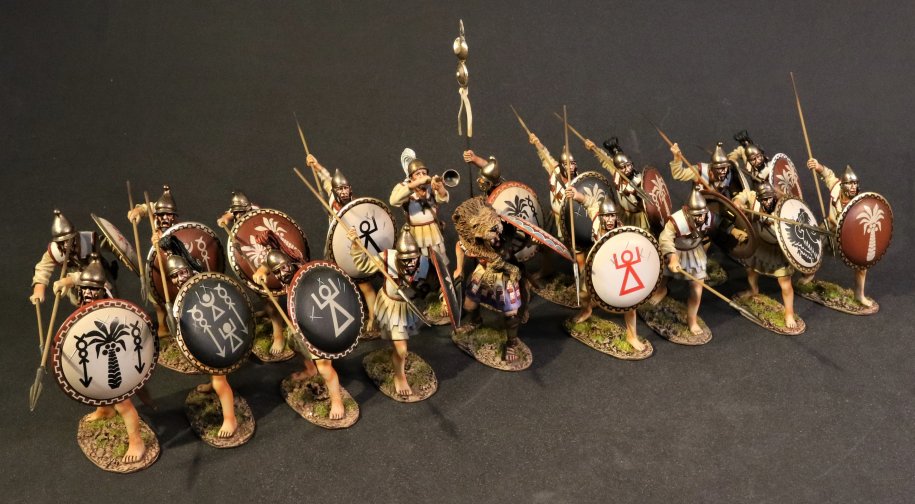
The backbone of any Carthaginian army and their most reliable troops were the Liby-Phoenician spearmen. The Libyans were not merely mercenaries but could be provided by allied city states or might have been conscripted from a peasant base.
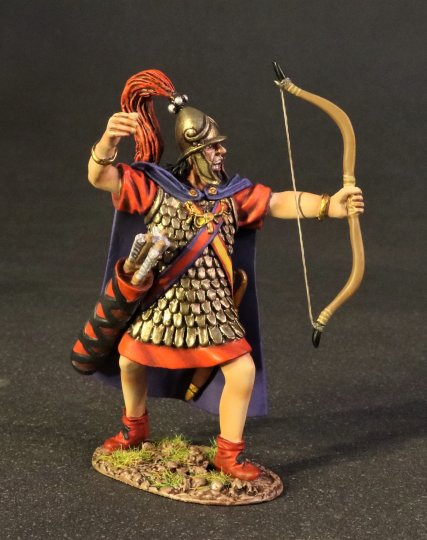
CTL-01
ARMIES AND ENEMIES OF ANCIENT ROME,
THE CARTHAGINIANS,
CARTHAGINIAN OFFICER.
(1 pc)
Before Hannibal’s Italian campaign they were presumably armed with long spears, round or oval shields and wore bronze helmets, and wore a linen cuirasses as protective armour.
THE ANCIENTS COLLECTION
ARMIES AND ENEMIES OF ANCIENT ROME
REPUBLICAN ROMANS
THE ROMAN ARMY OF THE LATE REPUBLIC

By the first decades of the 1st century, the COHORT had replaced the maniple as the standard tactical unit of the legions.
The three lines of the manipular legion were combined to form the cohort, which generally numbered about 480 to 500 men. Maniples and centuries continued to be used as military and administrative subdivisions for the cohort.
There were six centuries in a cohort, which were now all 80-men strong.
Each Centuria was commanded by a Centurion, and also included an Optio, a Signifer and a Cornicen.

RR-01AR
ARMIES AND ENEMIES OF ANCIENT ROME,
THE ROMAN ARMY OF THE LATE REPUBLIC,
CENTURION.
(1 pc)

RR-01AW
ARMIES AND ENEMIES OF ANCIENT ROME,
THE ROMAN ARMY OF THE LATE REPUBLIC,
CENTURION.
(1 pc)
The Centurions also appointed the bravest men as standard bearers, or Signifers.
A signifer was a standard bearer of the Roman legions. He carried a signum (standard) for a cohort or century. Each century had a signifer so there were 59 in a legion. Within each cohort, the first century's signifer would be the senior one.
The signum that he carried was the military emblem of that unit. It had a number of phalarae (disks or medallions) along with a number of other elements mounted on a pole. The pole could be topped with a leaf-shaped spear head or later a manus (open human hand) image denoting the oath of loyalty taken by the soldiers. It sometimes included a representation of a wreath, probably denoting an honour or award.
The task of carrying the signum in battle was dangerous, as the soldier had to stand in the first rank and could carry only a small buckler. It was that banner that the men from each individual century would rally around. A soldier could also gain the position of discentes signiferorum, or standard bearer in training. If the signifer was lost in battle, the whole unit was dishonored.
In addition to carrying the signum, the signifer also assumed responsibility for the financial administration of the unit and functioned as the legionaries' banker. He was paid twice the basic wage.

RR-02AR
ARMIES AND ENEMIES OF ANCIENT ROME,
THE ROMAN ARMY OF THE LATE REPUBLIC,
SIGNIFER.
(1 pc)

RR-02AW
ARMIES AND ENEMIES OF ANCIENT ROME,
THE ROMAN ARMY OF THE LATE REPUBLIC,
SIGNIFER.
(1 pc)
An Optio was an officer appointed by the centurion, and was stationed at the rear of the centuria to keep the troops in order. Their duties would include enforcing the orders of the centurion, taking over the centurion's command in battle should the need arise, supervising his subordinates, and a variety of administration duties. Optio pay was double the standard legionary pay and they were the most likely men to replace the centurion if the position became vacant.
A Centurion at this time can be distinguished from other Legionaries by several methods. He usually wore greaves, and the crest of his helmet was usually turned so it ran transversely across the helmet. His sword was worn on the left and his dagger on the right which is the opposite of a Legionaire.

RR-03AR
ARMIES AND ENEMIES OF ANCIENT ROME,
THE ROMAN ARMY OF THE LATE REPUBLIC,
OPTIO.
(1 pc)

RR-03AW
ARMIES AND ENEMIES OF ANCIENT ROME,
THE ROMAN ARMY OF THE LATE REPUBLIC,
OPTIO.
(1 pc)
Each Centuria would also contain a hornblower or Cornicines. A cornicen (plural cornicines) was a junior officer in the Roman Army. The cornicen's job was to signal salutes to officers and sound orders to the legions. The cornicines played the cornu (making him an aeneator). Cornicines always marched at the head of the centuries, with the signifer. The cornicines were also used as assistants to a centurion (like an optio). The cornicen was a duplicary or a soldier who got double the basic pay of the legionary.
The legion was now composed of ten cohorts rather than thirty maniples, and numbered an average of about 5,000 men.
ARMIES AND ENEMIES OF ANCIENT ROME
THE CARTHAGINIANS AND THEIR ALLIES
The military of Carthage was one of the largest military forces in the ancient world. Although the navy was always Carthage’s main force, the army acquired a key role in the spread of Carthaginian power.
With its Phoenician origins, Carthage already had a long history as a seafaring people. This was helped in that the navy was a permanently manned force, whilst the army would be enlisted only for a particular campaign and then demobilized.
Therefore it was easier to understand how the Carthaginian army was a Combined arms force, which comprised light and heavy infantry, skirmishers, light and heavy cavalry, as well as elephants.
The supreme command of the military was initially held by the civilian “Suffetes” until the third century. Thereafter, professional military generals were appointed directly by the Carthaginian Senate.
Whilst the navy was mainly manned by citizens, the army was composed almost exclusively of foreign mercenary units, particularly Libyans, Numidians, Iberians, Gauls and Greeks.
Only when the city of Carthage itself was threatened would citizens be conscripted into infantry service.

BCTL-01
ARMIES AND ENEMIES OF ANCIENT ROME,
THE CARTHAGINIANS,
CARTHAGINIAN OFFICER.
(1 pc)
LIBYAN – PHOENICIAN INFANTRY

The backbone of any Carthaginian army and their most reliable troops were the Liby-Phoenician spearmen. The Libyans were not merely mercenaries but could be provided by allied city states or might have been conscripted from a peasant base.

CTL-01
ARMIES AND ENEMIES OF ANCIENT ROME,
THE CARTHAGINIANS,
CARTHAGINIAN OFFICER.
(1 pc)
Before Hannibal’s Italian campaign they were presumably armed with long spears, round or oval shields and wore bronze helmets, and wore a linen cuirasses as protective armour.


